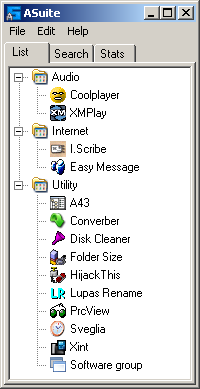Program usage
In the main window, under the List tab, user can be able to create and manage own customized application list. While Search tab will let you look for item names. [5]
User can add applications to list manually (with Add function or Drag and drop) or using Scan File. ASuite lets you specify the path, what file types you want to scan for and what file types you want to exclude from your scan. [5] [6]
Other than the main window, user can execute applications from a graphic and skinnable menu Windows XP style. This menu can open it by clicking on ASuite icon in System tray. [5]
Moreover, ASuite opens applications using relative path. So it can work on any storage device, like external hard disks and USB flash drives. [6] [7]
This page is based on this
Wikipedia article Text is available under the
CC BY-SA 4.0 license; additional terms may apply.
Images, videos and audio are available under their respective licenses.
